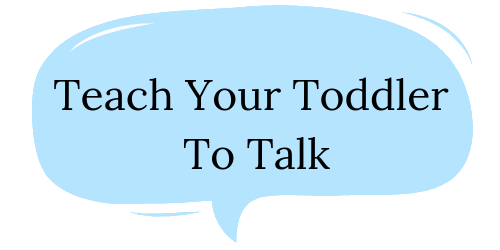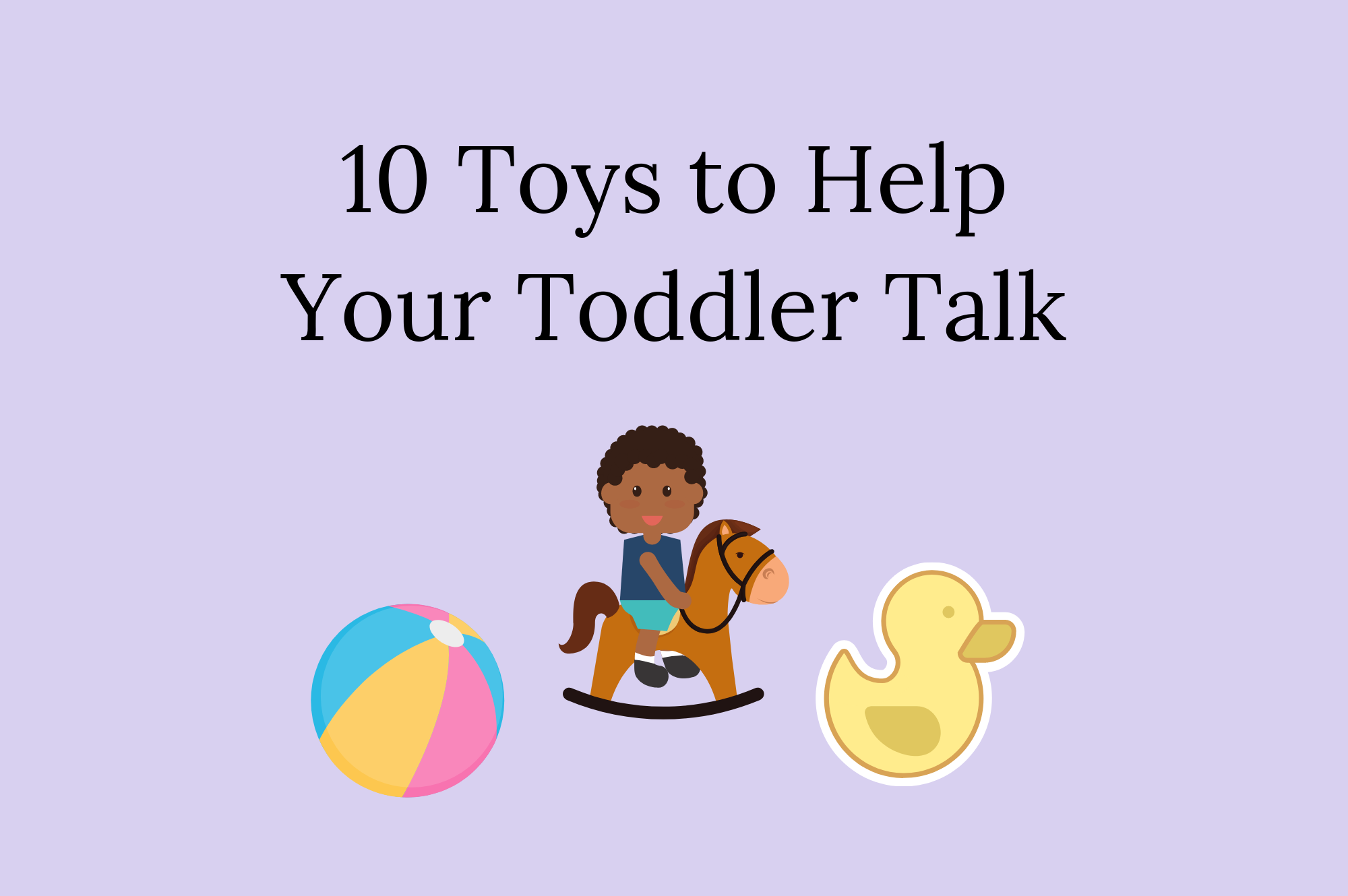As a speech therapist, I am constantly on the hunt for new toys to use with the late talking toddlers on my caseload. There are thousands of toys out there, many of which do exciting things like spin, light up and make noises. But what I have found is that the toys that work the best for language development are not the exciting, flashy toys. They are the simple toys you have at home. They are the toys that have the potential to teach back and forth interaction, pretend play and new vocabulary.
How Do Children Learn Language?
Toddlers who are late to start talking may need an added boost to get them to start using words. We know that children learn language from hearing words, learning to copy them, then eventually saying them on their own. You can provide your toddler with extra opportunities to hear and copy language by playing and talking with them more, and creating opportunities to communicate with these tips!
10 Toys to Help Your Toddler Talk
1) Ball
I’m sure everyone has some sort of ball at home! I use balls all the time with little ones, especially those who are active and like to move. First, throwing or rolling a ball back and forth is great to develop early communication skills such as turn taking and sustained attention. The longer a child is able to stay in an interaction, the more opportunities they will have to learn language. They also learn to wait, watch the other person, and copy what they do. You can also play by taking turns throwing a ball into a large basket. Model the same words each time so your toddler knows what to expect.
Here are some ideas for modelling a variety of words during your play. Pick just 1 or 2 words to focus on at first.
Noun: ball!
Verbs/Actions: throw, roll, catch
Concepts: up/down, in/out
2) Little people & bus
A toy bus can create lots of language learning opportunities! First, for any vehicle toy there are opportunities to make lots of fun vehicle sounds for your child to potentially copy. Even though they aren’t real words, sounds can be easier to copy than words if your child isn’t saying words yet. You can also do lots with the little people toys, like putting them “in” the bus and taking them “out”, or making them walk and saying “walk, walk, walk” for each step. You can also built anticipation before you push the bus across the room by saying “ready, set….go!” By using this phrase many, many times, eventually your child might finish the phrase when you pause and say “go” on their own!
Sounds: vroom, beep beep
Nouns: bus, wheel, door
Verbs/Actions: drive, stop, go
Concepts: open/close (the doors), fast/slow, in/out
Songs: Wheels on the Bus
Phrase: Ready, set, go!
3) Bubbles
Most toddlers are excited by bubbles, so I use these a lot in my therapy sessions. Bubbles are a great way to tempt a child to say a word! What I do, is blow the bubbles a few times to get their interest. Then I stop and wait. I look at the child expectantly, like I am waiting for them to do something. As soon as they make it clear that they want more (by reaching, making eye contact, or making a sound), I say “bubble” and wait. I want to give the opportunity to copy the word by modelling the word and waiting. I’ll repeat the word 2-3 times, and then blow the bubbles. It’s okay if they don’t say the word, we want to continue the interaction and give them lots of opportunities to try! An important thing to remember is that you want to try to maintain control of the bubbles, so your child needs to ask for more. That way, you are tempting your child to communicate with you. If they have the bubbles, you are losing that temptation to communicate!
Other words you can model: “more”, “pop” (as you pop the bubbles), “blow”
4) Potato Head
This is a great activity for modelling new words for your child and to help them learn their body parts! I will typically put all the pieces into a bag and pull out one at a time. I’ll give them the first one for free so they get a chance to explore the item and put it in the potato without much work. For the next item, I’ll pull it out of the bag and label the item (“eyes!”). I’ll wait to see if they will attempt the word. If they do, I will give them the item right away. If they don’t, I will repeat the word a couple more times, and then give them the item. It’s okay if they don’t say the word, we still want to give them the item, because we want to keep this fun and continue the interaction. You can continue to do this for each item. Make sure to make it fun by being animated, and don’t be afraid to be silly! You can try to wear the little glasses or put the hat on your head! The more fun you are, the more engaged your little one will be!
Nouns: eyes, ears, nose, mouth, hat, glasses etc.
Concepts: in/out
5) Kitchen set
I love a kitchen set for working with late talkers! Not only are there numerous opportunities to model language, but there are also opportunities for your child to copy your actions in play, which is a prerequisite skill to talking. Typically, before children are able to copy your words, they will start to copy your actions. In kitchen play, you might pretend to eat the apple, or stir the pot. See if they copy you! Talk about what you are doing, or what your child does (“you’re stirring!”)
Nouns: name the food items you play with
Verbs/Actions: stir, pour, cook
Concepts: in/out (of the pot or oven)
6) Baby doll
Similar to kitchen play, playing with baby dolls are also a great way to practice your child’s pretend play skills while modelling language. The skill of pretend play is shown to be linked to language development, so by supporting your child’s ability to pretend, you are helping them develop their language skills. You can model lots of different actions during play such as feeding the baby and the “shh” gesture when you put them to sleep.
Nouns: baby, bottle
Verbs/Actions: drink, eat, sleep, “shh”
7) Toy phone
A toy phone is another great option for practicing simple pretend play. Model talking on the phone, and then give them the phone and see what they do! You can even just make sounds into the phone to encourage imitation, as it’s easier to copy sounds than full words. By babbling with your toddler, you encourage that back and forth interaction and foundational communication skills. Lots of phones you can buy right now make lots of distracting noises, so I would just stick to something simple, or you can even use blocks or other toys and pretend they are phones.
8) Farm set

You can encourage imitation with farm toys by modelling actions and sounds for your child to copy. Make the cow jump and say “jump jump jump”. See if your child will copy you. If they don’t, take their hand with the toy in it and make it jump! Make the animal sounds and have fun with it! If you are silly, your child is more likely to think it’s funny and want to join in the fun.
Sounds: nay, moo, oink, baa etc
Nouns: horse, cow, pig, sheep etc
Actions: eat, sleep, run, jump
9) Piggy bank

Toddlers often love putting one thing inside something else, which is why piggy banks are so much fun. You can also use an empty baby wipes box with some toys that will fit inside. I like to set up a little verbal routine, which means that I do the same thing each time to help teach the child the meaning of the words, and get them to know what to expect so it’s more likely they will say the word. An example of a verbal routine is: “put it in” (putting the coin in); “knock knock knock” (knock on the door); “take it out (as you take out the coin and put it to the side). Then you get the next coin and do it again. Knocking is a great action for your child to copy, and easier than copying the word if that’s still tricky for them.(note: if your piggy bank makes sounds, I suggest not to put batteries in as that can distract from all the amazing language you are modelling)
Concepts: in/out
Actions: knock, open
10) Simple Books
So books are not technically a toy, but I included them because they are such a great tool for language learning. If your child is not yet saying many words, you want to choose a simple book with pictures that you can easily point to. You read the words on the page, or you can make up your own! It’s often more engaging to wait to see what pictures your child is interested in and then comment on that “Yes it’s a horse.. The horse says nayyy…The horse is eating”. If your child is very active and won’t sit still for long, that’s okay! Keep reading short, but often. Pick books with fun flaps and different textures to make it more engaging. Keep your comments short and repeat them, and feel free to sing songs as well!








